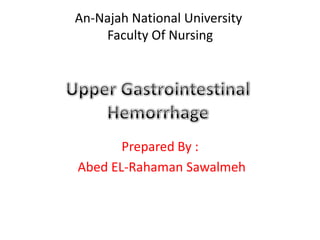
Upper GI bleeding
- 1. An-Najah National University Faculty Of Nursing Prepared By : Abed EL-Rahaman Sawalmeh
- 2. Outline • Anatomy of Digestive System • Definition • Introduction • Causes • Presentations, Lab findings and Diagnostics • Management • Physical examination • Summary Upper GI Hemorrhage
- 3. Anatomy of Digestive System
- 4. Definition Upper Gastrointestinal (GI) Hemorrhage refers to hemorrhage in the upper gastrointestinal tract. The anatomic cut-off for upper GI bleeding is the ligament of Treitz, which connects the fourth portion of the duodenum to the diaphragm near the splenic flexure of the colon. Upper GI bleeds are considered medical emergencies, and require admission to hospital for urgent diagnosis and management. Due to advances in medications and endoscopy, upper GI hemorrhage is now usually treated without surgery. Upper GI Hemorrhage
- 5. Introduction • Upper GI Hemorrhage is a very frequent medical problem. • Bleeding Peptic Ulcer, Portal hypertension, Gastritis and Esophageal varcies are the common causes for hemorrhage. • Hematemesis or melena is usually present unless rate bleeding is minimum. • Acute bleeding stops spontaneous is 75%cases. • Rest of the patient’s require surgery or die out of complications. Upper GI Hemorrhage
- 6. Causes • A number of medications increase the risk of bleeding including NSAIDs and SSRIs. • SSRIs double the rate of upper gastrointestinal bleeding. • There are many causes for upper GI hemorrhage. Causes are usually anatomically divided into their location in the upper gastrointestinal tract. • People are usually stratified into having either variceal or non-variceal sources of upper GI hemorrhage, as the two have different treatment algorithms and prognosis. Upper GI Hemorrhage
- 7. Incidence CommonCauses Peptic Ulcer 45% Duodenal Ulcer Gastric Ulcer Esophageal varcies 20% Gastritis 20% Mallore-Weiss Syndrome 10% UncommonCauses 5% Gastric Carcinoma Esophagitis Pancreatitis Upper GI Hemorrhage
- 8. Presentations, Lab findings and Diagnostics Patients with upper GI hemorrhage often present with hematemesis, melena, or hematochezia. If the hemorrhage is severe. The presentation of bleeding depends on the amount and location of hemorrhage. • Hematemesis – Vomiting of blood is common when bleeding originates from stomach or esophagus. – Coffee-ground when gastric acid converts hemoglobin into methemoglobin. Upper GI Hemorrhage
- 9. Presentations, Lab findings and Diagnostics • Melena – Passage of black tarry stools are common when there is bleeding from any part of Upper GIT. – The black color of melenic stool is caused by Hematin, the product of oxidization of Haem by intestinal and bacterial enzymes. • Hematochezia – It is defined as passage of bright-red blood from the rectum. – Common in bleeding from Colon, Rectum and Anus. – In case of brisk bleeding in the Upper GIT, Bright red blood may come out uncharged in the stool. Upper GI Hemorrhage
- 10. Presentations, Lab findings and Diagnostics • Patients may also present with complications of anemia, including chest pain, syncope, fatigue and shortness of breath. • The physical examination performed by the physician concentrates on the following things: – Vital signs, in order to determine the severity of bleeding and the timing of intervention – Abdominal and rectal examination, in order to determine possible causes of hemorrhage – Assessment for portal hypertension and stigmata of chronic liver disease in order to determine if the bleeding is from a variceal source. Upper GI Hemorrhage
- 11. Presentations, Lab findings and Diagnostics The diagnosis of upper GI bleeding is assumed when hematemesis is documented. In the absence of hematemesis, an upper source for GI bleeding is likely in the presence of at least two factors among: Black stool ##Age< 50 years ##BUN/Creatinine ratio 30 or more. In the absence of these findings, consider a nasogastric aspirate to determine the source of bleeding. If the aspirate is positive, an upper GI bleed is greater than 50%, but not high enough to be certain. If the aspirate is negative, the source of a GI bleed is likely lower. Upper GI Hemorrhage
- 12. Presentations, Lab findings and Diagnostics • In a study published regarding a new scoring system called the Glasgow-Blatchford bleeding score in Lancet on January 3, 2009, 16% of patients presenting with upper GI bleed had GBS score of "0", considered low. • Among these patients there were no deaths or interventions needed and the patients were able to be effectively treated in an outpatient setting. • Score is equal to "0" if the following are all present: – Hemoglobin level >12.9 g/dL (men) or >11.9 g/dL (women) – Systolic blood pressure >109 mm Hg – Pulse <100/minute – Blood urea nitrogen level <18.2 mg/dL – No melena or syncope – No past or present liver disease or heart failure Upper GI Hemorrhage
- 13. Management Initial assessment and management goals: – Assessment of the statues of the circulatory system and replace blood loss as necessary (ABC) – Determine the amount and rate of bleeding. – Slow or stop the bleeding by ice-water lavage. – Discover the lesions responsible for the episodes. – Specific management for underlying causes. Upper GI Hemorrhage
- 14. Physical examination • The goal of the patient’s physical examination is to evaluate for shock and blood loss. • Signs of shock include cool extremities, oliguria, chest pain, pre-syncope, confusion, and delirum. • Hematemesis and melena should be noted. Upper GI Hemorrhage
- 16. Thank you !
